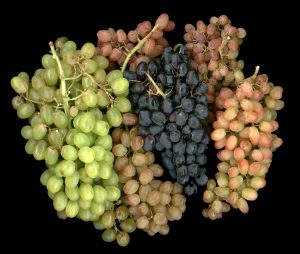March 15th, 2025
The Art of Blending Grapes
Blending grapes is a traditional practice in winemaking, allowing winemakers to craft wines that are perfectly balanced, complex, and consistent. But why do winemakers blend, and what are the most commonly used grapes in the world of blended wines?
Why Blend Grapes?
Blending serves multiple purposes, each helping to producing a well-rounded wine:
- Balance: Some grapes bring high acidity, while others contribute richness or tannin. Combining them ensures a harmonious structure.
- Complexity: A single grape variety may have limited flavor dimensions. Blending enhances aromatic and taste profiles.
- Consistency: Different vintages produce varying qualities of grapes. Blending allows winemakers to maintain a consistent style year after year.
- Enhanced Aging Potential: Some grapes age better than others. By blending, winemakers can extend a wine’s longevity.
Most Common Blending Grapes
Several grape varieties are widely used for blending, each bringing unique characteristics:
Red Blending Grapes:
- Cabernet Sauvignon – Adds structure, tannins, and black fruit flavors.
- Merlot – Softens tannins and adds plush fruitiness.
- Syrah (Shiraz) – Brings spiciness, dark fruit, and depth.
- Grenache – Offers red fruit, warmth, and approachability.
- Malbec – Contributes deep color, plum flavors, and softness.
- Petit Verdot – Used in small amounts for color, floral notes, and spice.
White Blending Grapes:
- Chardonnay – Commonly blended for texture and body.
- Sauvignon Blanc – Provides crisp acidity and citrus flavors.
- Semillon – Adds richness and honeyed notes.
- Viognier – Brings floral aromatics and roundness.
- Roussanne & Marsanne – Used in Rhône blends for depth and structure.
Regions Famous for Blended Wines
Blending is especially popular in certain wine regions where multiple grape varieties thrive:
- Bordeaux, France – Home to some of the world’s most famous red and white blends. Red Bordeaux wines typically mix Cabernet Sauvignon, Merlot, and other grapes, while whites combine Sauvignon Blanc and Semillon.
- Rhône Valley, France – Renowned for blends like Châteauneuf-du-Pape (often featuring Grenache, Syrah, and Mourvèdre, known as the GSM blend).
- Champagne, France – Almost all Champagne is a blend of Chardonnay, Pinot Noir, and Pinot Meunier to achieve balance and complexity.
- Rioja, Spain – Tempranillo is commonly blended with Garnacha and other native varieties for a nuanced red wine.
- Tuscany, Italy – Super Tuscan wines blend Sangiovese with Cabernet Sauvignon, Merlot, and Syrah for modern expressions.
- Australia – GSM blends are popular in South Australia, while Cabernet-Shiraz blends create bold, powerful reds.
- California, USA – Bordeaux-style blends (often called “Meritage”) and Rhône-style blends are widely produced.
Blending is an art that allows winemakers to craft wines that balance acidity, tannins, fruit, and structure. Whether it’s a bold Bordeaux blend, a spicy Rhône GSM, or a rich white from the south of France, the tradition of blending grapes continues to shape the world of wine, offering endless complexity in every glass.



